The 2018 Apple iPad Pro (11-Inch) Review: Doubling Down On Performance
by Brett Howse & Andrei Frumusanu on December 4, 2018 10:00 AM ESTThe Liquid Retina Display
Apple offers some of the best displays on the market, and the iPad Pro is arguably their best display available. What Apple calls a Liquid Retina display is a 264 pixel-per-inch masterpiece. The 11-inch model we are reviewing holds a 2388x1668 7:5 aspect ratio panel, while the larger 12.9-inch model uses a 4:3 2732x2048 panel.
There’s a lot that sets Apple apart from other manufacturers on the market. The company has taken display accuracy seriously longer than anyone outside of the professional field. The display in the iPad Pro is also a P3 D65 gamut display, but thanks to the color management system that Apple moved over from the Mac, it simultaneous offers near-perfect sRGB reproduction as well as near-perfect P3 reproduction whenever an app or image specifically says it's P3. There’s no compromise on offering the P3, and no need to change the gamut on the display to match different color spaces. It’s a P3 display where sRGB is properly mapped.
In addition, Apple’s iPad Pro offers their ProMotion technology, which means it is a 120 Hz display, but one that supports variable refresh rates in order to lower the display's refresh rate for power management purposes. The iPad Pro will go as low as 24 Hz, presumably chosen to match the framerate of most movies. Apple also carries over its True Tone functionality, where ambient light sensors change the white point of the display to make it more suited to the environment it is in. It’s one of those features you never really knew you needed until you see it in action.
The fully laminated display also offers Apple’s industry leading antireflective coating, which Apple rates at 1.8% reflectivity, improving the results outdoors dramatically over most devices, and of course there is a fingerprint-resistant oleophobic coating as well.
Apple rates the latest iPads at up to 600 nits of brightness too, so pretty much no matter where you are, the combination of the high brightness and the antireflective coating should make for a great viewing experience.
To test the display characteristics, we turn to SpectraCal’s CalMAN software suite, along with an X-Rite i1Display Pro colorimeter for brightness and contrast readings, and the X-Rite i1Pro 2 spectrophotometer for color accuracy readings.
Brightness and Contrast
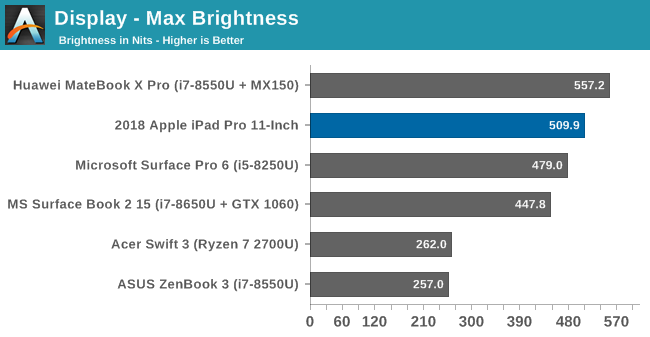
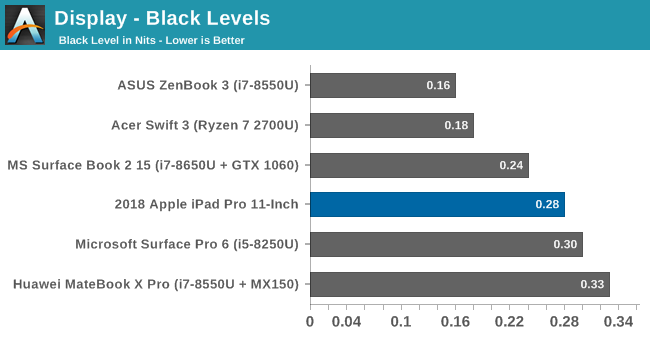
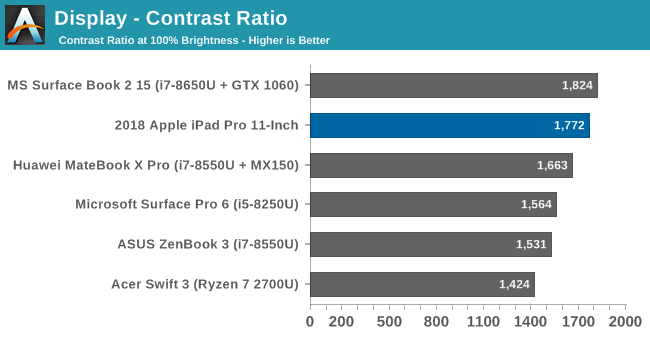
Under our test conditions the iPad Pro could not quite hit the 600 nits that Apple advertises, but at 500 nits it is still plenty bright. Couple that with the excellent contrast ratio of almost 1800:1, and things are off to a good start.
Grayscale
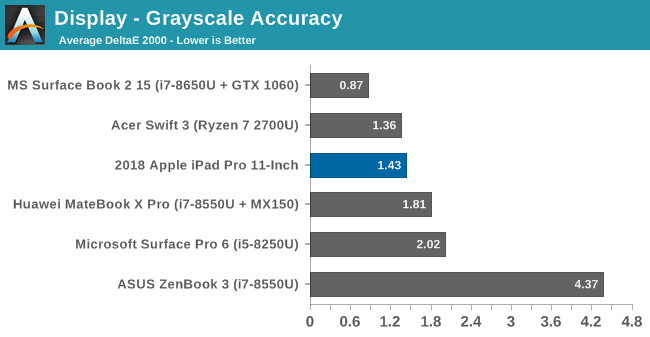
The average dE2000 of 1.43 is a fantastic result, but the gamma isn’t quite perfect, dropping off near 100% because the display was slightly too bright. Unfortunately, the red results were quite low throughout the entire range leading to a slightly cooler display white point, but this is all quite minor.
Gamut
First let’s take a look at sRGB:

As you can see, the sRGB values are almost perfectly mapped into the P3 D65 gamut, and the average error level of just over 1.09 is simply fantastic. All of the primary and secondary values are close to perfect, except red which was a bit low at 100% red, as we saw in the grayscale results.
Next up, P3 D65:
As with the sRGB results, the P3 D65 gamut is also almost perfect. The beauty of color management means that there’s no work for the user to get the benefit of both P3 and sRGB.
Saturation

The saturation sweep was run in sRGB, and as you can see from the graphs, all along all of the primary and secondary colors the error level is basically imperceptible to the human eye.
Gretag Macbeth
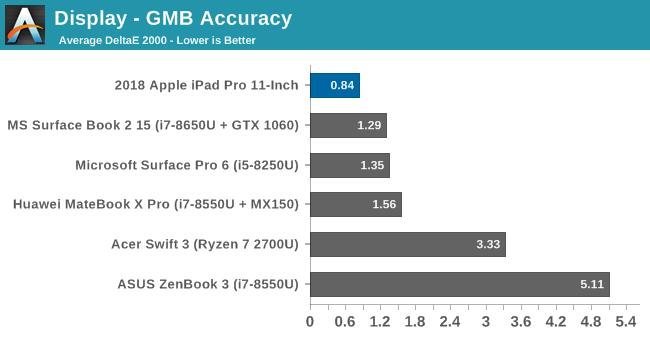
Finally, the Gretag Macbeth test is a more comprehensive test, hitting colors outside of the primary and secondary colors, including the important skin tones. The error level is practically perfect, with no single color even hitting an error level of 2.0.
Display Conclusion
The iPad Pro simply offers one of the best displays on any electronic device. Color accuracy is superb, in both the P3 and sRGB gamuts, and thanks to iOS supporting full color management, customers don’t have to worry about if they are working on a P3 or sRGB image. The addition of True Tone makes for an incredibly pleasing white point in pretty much any situation, and the 120 Hz display refresh rate makes for smooth scrolling, while stepping down to lower refresh rates to conserve power when the display is static.


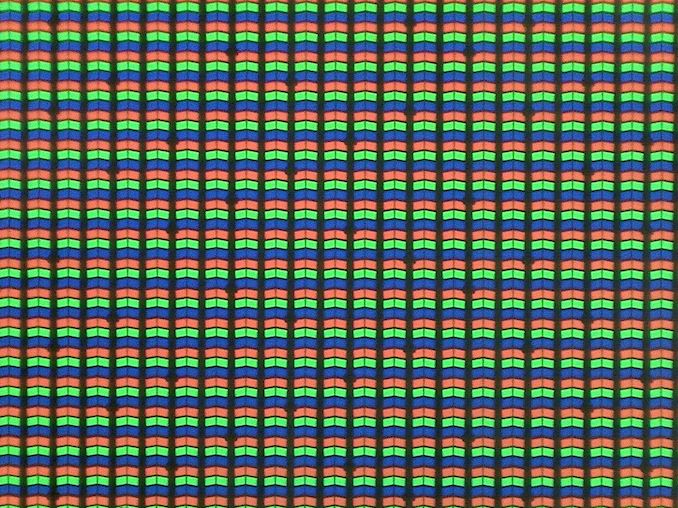


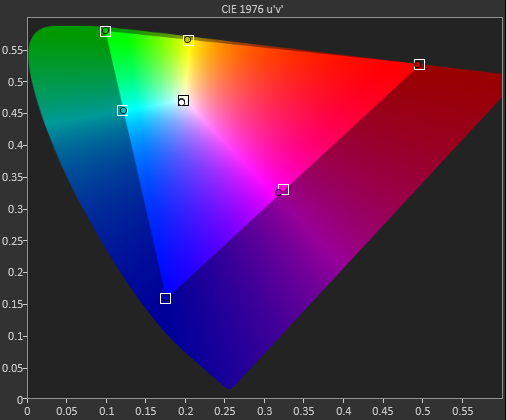










145 Comments
View All Comments
Spunjji - Wednesday, December 5, 2018 - link
Honestly wondered this too. Apple don't seem to like performance segmentation at the top-end, and I'd bet that 1TB unit uses TLC flash, so extra caching in system RAM would massively help performance and longevity. Just a supposition though.Socius - Wednesday, December 5, 2018 - link
I picked up the 1TB model for the 6GB of ram. Apps/games stay in memory far longer than they do on the iPhone XS Max with 4GB of ram. Of course, that could also be related to the way iOS is designed to perform on iphones vs. ipads. But either way, the 1TB model also has a much faster disk. If you use your iPad for productivity, I would try to find a way to justify the extra expenditure. My justification was the pending release of Adobe Photoshop, as well as trying to do some of my 4K video editing strictly on the iPad.Speedfriend - Tuesday, December 4, 2018 - link
If the single core power consumption is 3.6-4.3, what would it be at most stressed multicore?eastcoast_pete - Tuesday, December 4, 2018 - link
Writing this as somebody who is not an iOS fan or Apple fanboy, this tablet is clearly the reigning king of tablets, with the pricing to match. However, a laptop replacement it is not, despite what Apple keeps saying. The one aspect that I did find disappointing is the rear camera setup; despite statement by some of Apple's head-honchos, plenty of people I know do use their tablet (usually iPads) for photography, and for the current iPad Pro prices, Apple could have thrown in the camera setup from the iPhone XS.KPOM - Tuesday, December 4, 2018 - link
I think what Apple is saying is that it does what most people need a computer to do, not that it would replace everything a notebook does. For me, it does about 90% of what I need. This plus a low-end ultralight notebook with a big screen would be all I need right now. My employer insists on giving me a quad-core notebook that weighs a bulky 3.5 lbs. I’d take a Spectre over my PC setup. On business trips, the iPad is all I need.WasHopingForAnHonestReview - Wednesday, December 5, 2018 - link
So, email. K.crash86 - Tuesday, December 4, 2018 - link
On the GPU test - it looks like there is no change in resolution between the iPAD 1112x834 and 2224x1668 settings. Instead, it looks like the rendered resolution is exactly the same, just scaled by 2X (the @2.0?). Are you sure the rendered resolution actually changed between the tests? It seems unreasonable that the average / frame would be completely unchanged.Ryan Smith - Tuesday, December 4, 2018 - link
We're sure.Take a good look at the photos. The Retina resolution photos are far clearer since they're not being internally rendered at 1/4 resolution.
tipoo - Tuesday, December 4, 2018 - link
That's wild.*ask to render 4x more pixels*
A12X: *Shrugs*
KateH - Wednesday, December 5, 2018 - link
the author said the framerate appeared to be capped at 27fps (presumably for the sake of power consumption and thermals). So we don't know how fast it could render Civ at full tilt, only that it's at least 27fps at both resolutions. I assume this just means the GPU is just working less hard to hit the framerate at the lower resolution, but we don't know how much... Apple may have GPU design chops but even they can't magic their way out of resolution performance scaling limits, only obfuscate said limits ;)